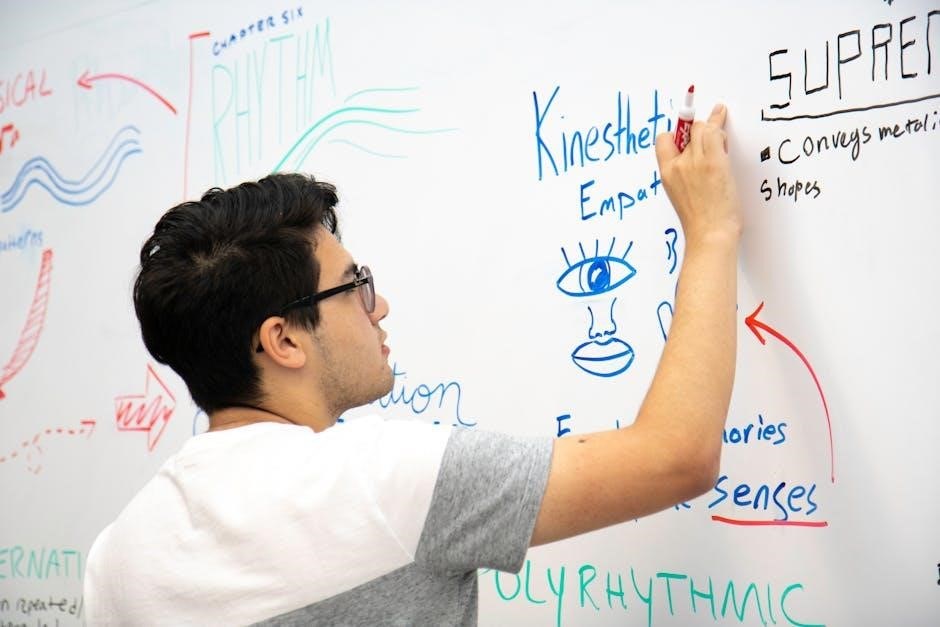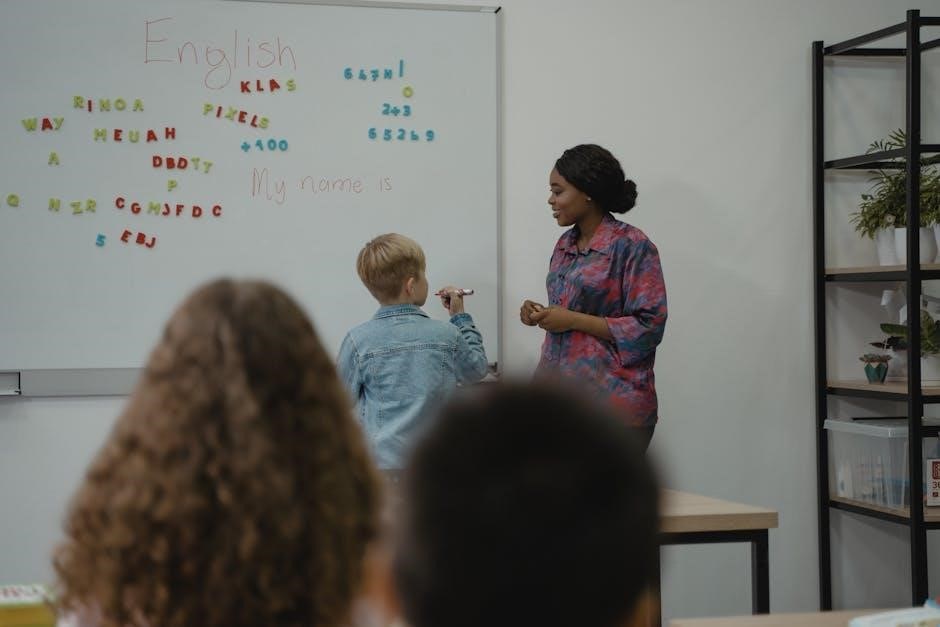Direct Instruction is a teacher-led method emphasizing clear explanations, examples, and structured delivery to ensure students grasp concepts effectively, fostering active engagement and measurable learning outcomes.
1.1 Definition and Overview
Direct Instruction is a teacher-directed teaching method characterized by clear, structured delivery of content. It involves the teacher presenting information systematically, using examples and explanations to ensure students understand key concepts. This approach emphasizes active teaching, where the educator takes the lead in guiding students through lessons, often using lectures, demonstrations, and guided practice. Direct Instruction is designed to maximize student engagement and learning outcomes by providing explicit guidance and minimizing ambiguity. It is particularly effective for teaching foundational skills and complex ideas, as it allows for consistent pacing and immediate feedback.
1.2 Importance of Direct Instruction in Education
Direct Instruction plays a vital role in education by ensuring clarity, structure, and effectiveness in teaching. It enables teachers to deliver content systematically, making it easier for students to grasp complex concepts. This method is particularly beneficial for diverse learners, as it provides explicit guidance and reduces ambiguity. By focusing on clear explanations and examples, Direct Instruction helps students build a strong foundation of knowledge. It also promotes active engagement and higher academic outcomes, as teachers can monitor progress and adjust instruction accordingly. Ultimately, Direct Instruction fosters a learning environment where all students have the opportunity to succeed, regardless of their background or learning style.
1.3 Key Characteristics of Direct Instruction
Direct Instruction is characterized by a structured, teacher-centered approach that emphasizes clarity and precision. Lessons are carefully planned and scripted, ensuring that concepts are presented logically and sequentially. The teacher actively engages students through explicit explanations, modeling, and guided practice. Key features include the use of examples to illustrate points, repetition to reinforce learning, and a focus on mastery of skills. Instruction is fast-paced but deliberate, allowing for immediate feedback and adjustments. Engagement techniques, such as questioning and think-pair-share activities, are often incorporated to maintain student focus. These characteristics ensure that all learners, regardless of ability, can access and understand the content effectively.

Structure of a Direct Instruction Lesson Plan
A Direct Instruction lesson plan includes clear objectives, materials, introduction, delivery, guided and independent practice, and closure. Each component ensures systematic and engaging learning experiences for students.
2.1 Lesson Objectives
Lesson objectives in a Direct Instruction plan are specific and measurable, outlining what students will know or do by the end. They guide the entire lesson, ensuring focus and alignment with learning goals. Clear objectives help teachers deliver targeted instruction, allowing students to understand expectations and track progress. For example, an objective might state, “Students will identify and explain literary tropes in a given text.” These objectives are often derived from broader educational standards and are communicated clearly to students at the lesson’s start. They serve as the foundation for all subsequent activities and assessments, ensuring every moment is purposeful and aligned with desired outcomes. This clarity promotes efficient learning and helps maintain student engagement throughout the lesson. By setting specific goals, teachers can effectively measure student understanding and adjust instruction as needed. This structured approach ensures that all students have the opportunity to meet the established learning targets, fostering academic success and accountability in the classroom. The use of clear, measurable objectives is a cornerstone of the Direct Instruction method, enabling teachers to deliver high-impact lessons tailored to student needs. As a result, students are well-prepared to demonstrate their mastery of the material through various assessments and activities. The importance of well-defined objectives cannot be overstated, as they provide the roadmap for both instruction and evaluation, ensuring that each lesson is intentional and effective. Through this emphasis on clear goals, Direct Instruction empowers teachers to create learning environments where students can thrive and achieve their full potential. By maintaining a focus on specific, measurable outcomes, educators can address individual needs while promoting collective success, making Direct Instruction a powerful tool in modern education. The clarity and structure provided by lesson objectives are essential for maximizing student learning and ensuring that every lesson is both productive and meaningful. This approach not only enhances academic performance but also builds students’ confidence and motivation, as they are able to see their progress and understand how each activity contributes to their overall learning. In summary, the establishment of clear, specific lesson objectives is a critical component of Direct Instruction, enabling teachers to deliver focused, effective lessons that support student success and growth. By prioritizing well-defined goals, educators can create a structured and supportive learning environment that fosters engagement, understanding, and achievement for all students. The use of clear objectives ensures that every lesson is purposeful and aligned with broader educational aims, making Direct Instruction a valuable and effective teaching strategy in contemporary classrooms. Through the careful planning and communication of lesson objectives, teachers can ensure that students are well-equipped to meet the challenges of the curriculum and achieve their full academic potential. This emphasis on clear goals and structured instruction is a hallmark of the Direct Instruction approach and a key factor in its success. By setting specific, measurable objectives, educators can create a framework for learning that is both efficient and effective, supporting students as they work towards mastery of the material. The importance of lesson objectives in Direct Instruction cannot be overstated, as they provide the necessary focus and direction for both teaching and learning. Through this approach, teachers can ensure that each lesson is tailored to meet the needs of their students, providing a clear path to understanding and achievement. The careful development and communication of lesson objectives are essential for maximizing the effectiveness of Direct Instruction, enabling teachers to deliver lessons that are both engaging and impactful. By establishing clear, achievable goals, educators can create a learning environment that is conducive to student success, ensuring that every lesson contributes to the broader educational objectives. The use of well-defined lesson objectives is a fundamental aspect of Direct Instruction, providing the structure and focus necessary for effective teaching and learning. Through this approach, teachers can ensure that their students are well-prepared to meet the challenges of the curriculum and achieve their full potential. The clarity and specificity of lesson objectives are key elements in the success of Direct Instruction, enabling educators to deliver targeted, high-impact lessons that support student understanding and mastery. By prioritizing clear goals, teachers can create a structured and supportive learning environment that fosters academic success and personal growth for all students. The careful planning and communication of lesson objectives are critical components of the Direct Instruction method, ensuring that each lesson is both intentional and effective. Through this emphasis on clear, measurable outcomes, educators can address individual needs while promoting collective success, making Direct Instruction a powerful tool in modern education. The importance of well-defined objectives in Direct Instruction cannot be overstated, as they provide the necessary focus and direction for both teaching and learning. By setting specific, achievable goals, teachers can ensure that every lesson is purposeful and aligned with broader educational aims, supporting students as they work towards mastery of the material. The use of clear, specific lesson objectives is a cornerstone of the Direct Instruction method, enabling teachers to deliver high-impact lessons tailored to student needs. Through this approach, educators can create a framework for learning that is both efficient and effective, fostering engagement, understanding, and achievement for all students. The establishment of clear, specific lesson objectives is essential for maximizing the effectiveness of Direct Instruction, ensuring that each lesson is both intentional and meaningful. By maintaining a focus on specific, measurable outcomes, teachers can address individual needs while promoting collective success, making Direct Instruction a valuable and effective teaching strategy in contemporary classrooms. The clarity and structure provided by lesson objectives are critical components of Direct Instruction, enabling educators to create a learning environment that is conducive to student success. Through the careful development and communication of lesson objectives, teachers can ensure that students are well-prepared to meet the challenges of the curriculum and achieve their full academic potential. The emphasis on clear, achievable goals is a hallmark of the Direct Instruction approach and a key factor in its success. By prioritizing well-defined objectives, educators can create a structured and supportive learning environment that fosters engagement, understanding, and achievement for all students. The careful planning and communication of lesson objectives are essential for maximizing student learning and ensuring that every lesson is both productive and meaningful. This approach not only enhances academic performance but also builds students’ confidence and motivation, as they are able to see their progress and understand how each activity contributes to their overall learning. In summary, the establishment of clear, specific lesson objectives is a critical component of Direct Instruction, enabling teachers to deliver focused, effective lessons that support student success and growth. By prioritizing well-defined goals, educators can create a framework for learning that is both efficient and effective, fostering engagement, understanding, and achievement for all students. The use of clear, specific lesson objectives ensures that every lesson is purposeful and aligned with broader educational aims, making Direct Instruction a valuable and effective teaching strategy in contemporary classrooms. Through the careful planning and communication of lesson objectives, teachers can ensure that students are well-equipped to meet the challenges of the curriculum and achieve their full potential. This emphasis on clear goals and structured instruction is a hallmark of the Direct Instruction approach and a key factor in its success. By setting specific, measurable objectives, educators can create a learning environment that is conducive to student success, ensuring that every lesson contributes to the broader educational objectives. The use of well-defined lesson objectives is a fundamental aspect of Direct Instruction, providing the structure and focus necessary for effective teaching and learning. Through this approach, teachers can ensure that their students are well-prepared to meet the challenges of the curriculum and achieve their full potential. The clarity and specificity of lesson objectives are key elements in the success of Direct Instruction, enabling educators to deliver targeted, high-impact lessons that support student understanding and mastery. By prioritizing clear goals, teachers can create a structured and supportive learning environment that fosters academic success and personal growth for all students. The careful planning and communication of lesson objectives are critical components of the Direct Instruction method, ensuring that each lesson is both intentional and effective. Through this emphasis on clear, measurable outcomes, educators can address individual needs while promoting collective success, making Direct Instruction a powerful tool in modern education. The importance of well-defined objectives in Direct Instruction cannot be overstated, as they provide the necessary focus and direction for both teaching and learning. By setting specific, achievable goals, teachers can ensure that every lesson is purposeful and aligned with broader educational aims, supporting students as they work towards mastery of the material. The use of clear, specific lesson objectives is a cornerstone of the Direct Instruction method, enabling teachers to deliver high-impact lessons tailored to student needs. Through this approach, educators can create a framework for learning that is both efficient and effective, fostering engagement, understanding, and achievement for all students. The establishment of clear, specific lesson objectives is essential for maximizing the effectiveness of Direct Instruction, ensuring that each lesson is both intentional and meaningful. By maintaining a focus on specific, measurable outcomes, teachers can address individual needs while promoting collective success, making Direct Instruction a valuable and effective teaching strategy in contemporary classrooms. The clarity and structure provided by lesson objectives are critical components of Direct Instruction, enabling educators to create a learning environment that is conducive to student success. Through the careful development and communication of lesson objectives, teachers can ensure that students are well-prepared to meet the challenges of the curriculum and achieve their full academic potential; The emphasis on clear, achievable goals is a hallmark of the Direct Instruction approach and a key factor in its success. By prioritizing well-defined objectives, educators can create a structured and supportive learning environment that fosters engagement, understanding, and achievement for all students. The careful planning and communication of lesson objectives are essential for maximizing student learning and ensuring that every lesson is both productive and meaningful. This approach not only enhances academic performance but also builds students’ confidence and motivation, as they are able to see their progress and understand how each activity contributes to their overall learning. In summary, the establishment of clear, specific lesson objectives is a critical component of Direct Instruction, enabling teachers to deliver focused, effective lessons that support student success and growth. By prioritizing well-defined goals, educators can create a framework for learning that is both efficient and effective, fostering engagement, understanding, and achievement for all students. The use of clear, specific lesson objectives ensures that every lesson is purposeful and aligned with broader educational aims, making Direct Instruction a valuable and effective teaching strategy in contemporary classrooms. Through the careful planning and communication of lesson objectives, teachers can
2.2 Materials Needed

Materials needed for a Direct Instruction lesson plan are carefully selected to support clear delivery and student engagement. Common materials include whiteboards, markers, projectors, and printed handouts. Additional resources may involve visual aids like charts, graphs, or multimedia presentations to illustrate key points. For interactive elements, teachers might prepare structured worksheets, guided practice exercises, or paired-share activities. Technology tools, such as educational software or online platforms, can also be integrated to enhance learning. All materials are aligned with lesson objectives and are designed to facilitate active participation and understanding. Ensuring availability of these resources helps maintain a focused and productive learning environment, allowing students to engage fully with the content being taught.
The introduction and hook are critical components of a Direct Instruction lesson plan, designed to capture students’ attention and establish the lesson’s purpose. A strong hook might include a thought-provoking question, a relevant story, or a visual stimulus that connects to the topic; The teacher then provides a clear overview of the lesson’s objectives and relevance to students’ lives. This section sets the stage for engagement, ensuring students are mentally prepared to focus on the content. By linking the hook to the lesson’s main ideas, the teacher creates a smooth transition into the instructional phase, maintaining student interest and motivation from the outset. This structured approach ensures clarity and focus, setting the tone for effective learning.
2.4 Direct Instruction Delivery
Direct Instruction Delivery is the core of the lesson where the teacher explicitly presents information to students. This phase involves clear, structured explanations, demonstrations, and modeling of skills or concepts. The teacher uses pre-scripted lessons to ensure accuracy and consistency, delivering content at a pace that allows all students to follow. Key points are supported with examples, repetition, and visual aids to enhance understanding. The teacher actively engages students through questioning and checks for understanding to maintain focus and clarify misconceptions. This method ensures that students receive a coherent and systematic presentation of material, building a strong foundation for subsequent practice and application.
2.5 Guided Practice
Guided Practice follows Direct Instruction Delivery, allowing students to apply what they’ve learned under the teacher’s supervision. This phase involves collaborative activities, such as group work or paired tasks, where students work together to complete exercises or solve problems. The teacher circulates around the room to provide individualized support, answer questions, and address misconceptions. Guided Practice helps students build confidence and fluency while ensuring they understand the material before moving to independent tasks. It bridges the gap between teacher-led instruction and self-directed learning, fostering a sense of accountability and reinforcing newly acquired skills in a supportive environment.
2.6 Independent Practice
Independent Practice is the final phase where students apply skills and knowledge on their own, reinforcing what they’ve learned. This phase involves tasks such as worksheets, projects, or problem-solving activities that students complete individually. The teacher observes from a distance, allowing students to demonstrate mastery without assistance. Independent Practice helps identify students who may need additional support and ensures learners can apply concepts autonomously. It also prepares them for summative assessments by solidifying their understanding. This phase is crucial for building confidence and ensuring students can work independently, making it a key component of a Direct Instruction lesson plan.
2.7 Closure and Assessment
Closure and Assessment are the concluding steps in a Direct Instruction lesson plan, ensuring students consolidate learning and the teacher evaluates understanding. Closure involves summarizing key points, often through a brief review or class discussion, reinforcing the lesson’s main objectives. Assessment follows, using methods like exit tickets, quizzes, or informal checks to measure student mastery. This phase provides immediate feedback, allowing the teacher to identify areas where students may need additional support. It also helps in planning future lessons, ensuring no gaps in learning. Closure and Assessment are essential for maintaining accountability and ensuring the lesson’s goals are achieved effectively.

Key Components of Direct Instruction
Direct Instruction involves a structured approach with clear explanations, examples, and scripting to ensure all students understand the material, pacing instruction to maintain engagement and focus.
3.1 Lecture Method
The lecture method is a cornerstone of Direct Instruction, where teachers deliver information systematically. It involves clearly stating main points, introducing organizing ideas, and using examples to illustrate concepts. Repetition reinforces learning, ensuring clarity. Teachers engage students through questions and visual aids, fostering active participation. This method ensures all learners grasp the material, making it a key component of structured lesson plans.
3.2 Role of the Teacher
In Direct Instruction, the teacher plays a pivotal role as the primary facilitator of learning. They deliver content systematically, using clear explanations and examples to ensure understanding. The teacher maintains control of the instructional flow, pacing the lesson to meet student needs. They also engage students through questioning techniques and provide immediate feedback. Effective classroom management is crucial to create a focused learning environment. Teachers are responsible for scripting lessons, ensuring content is well-organized and accessible. Their active involvement ensures that all students, including those needing extra support, can master the skills being taught.
3.3 Scripting the Lesson
Scripting the lesson involves creating a detailed, structured plan that outlines every step of the instructional process. This ensures clarity and coherence, allowing teachers to deliver content effectively. A scripted lesson plan includes clear explanations, examples, and pacing guidelines to meet student needs. It aligns with learning objectives and incorporates engagement techniques to maintain focus. Scripting also ensures that all students receive consistent instruction, regardless of the teacher. By following a script, educators can manage time efficiently and cover all necessary material. This approach is particularly beneficial for teaching foundational skills, as it minimizes ambiguity and maximizes student understanding. Scripting is a cornerstone of Direct Instruction, ensuring lessons are purposeful and aligned with desired outcomes.
3.4 Pacing the Instruction
Pacing the instruction is crucial in Direct Instruction to ensure all students can follow and understand the content. Teachers must deliver material at a steady, controlled rate, avoiding both rushing and dragging. Proper pacing allows students to process information effectively and reduces the likelihood of confusion. It involves balancing lecture delivery with opportunities for student practice and feedback. Well-paced lessons keep students engaged and focused, preventing boredom or frustration. Pacing also ensures that the lesson stays aligned with the allocated time, covering all essential points without omitting critical details. Effective pacing is tailored to the class’s needs, adjusting speed as necessary to accommodate student responses and questions. This balance ensures efficient and productive learning environments.
3.5 Engagement Techniques
Engagement techniques are essential in Direct Instruction to maintain student focus and participation. Strategies like think-pair-share, cold calling, and hands-on activities encourage active involvement. Teachers use verbal and non-verbal cues to sustain interest, ensuring all students are attentive. Questioning techniques, such as open-ended and guided questions, stimulate critical thinking. Incorporating visual aids and multimedia enhances engagement by catering to different learning styles. Movement activities and group work also play a role in keeping students motivated. These techniques ensure that instruction is interactive and tailored to diverse needs, fostering a dynamic and inclusive learning environment. Effective engagement strategies are integral to achieving lesson objectives and promoting student success in Direct Instruction settings.

Direct Instruction Strategies
Direct Instruction Strategies include using examples to illustrate key points, repetition for reinforcement, questioning to check understanding, and visual aids to enhance engagement and clarity.
4.1 Using Examples to Illustrate Key Points
Using examples to illustrate key points is a fundamental strategy in Direct Instruction. Teachers provide clear, relevant examples to make abstract concepts tangible. For instance, when teaching literary tropes, instructors might use specific scenes from a novel to demonstrate foreshadowing. This approach enhances comprehension and retention, as students can connect new information to concrete examples. Examples should be varied to cater to different learning styles, ensuring all students grasp the concept. Additionally, incorporating multimedia, such as videos or images, can further reinforce learning. By grounding instruction in relatable examples, teachers create a structured and engaging environment that supports understanding and application of the material.
4.2 Repetition and Reinforcement
Repetition and reinforcement are critical components of Direct Instruction, ensuring students master skills and concepts. Teachers repeat key points multiple times, often using varied phrasing, to solidify understanding. For example, in a grammar lesson, instructors might review verb tenses through structured drills and practice exercises. Reinforcement involves positive feedback, such as praising correct answers, to encourage participation and confidence. Additionally, incorporating regular review sessions helps students retain information over time. This systematic approach minimizes confusion and builds a strong foundation for future learning, making it essential for achieving educational objectives effectively.
4.3 Questioning Techniques
Effective questioning techniques in Direct Instruction involve asking focused, clear questions to gauge student understanding and encourage critical thinking. Teachers use various types of questions, such as recall, application, and analysis, to assess comprehension and promote deeper engagement. For instance, during a lesson on literary tropes, a teacher might ask, “Can you provide an example of a simile from the text?” This approach ensures students are actively processing information. Additionally, questioning techniques like think-pair-share allow students to discuss answers in pairs before sharing with the class, fostering collaboration and reducing anxiety; Regular questioning helps identify knowledge gaps and adjust instruction accordingly, ensuring all students remain on track.
4.4 Visual Aids and Multimedia
Visual aids and multimedia are essential tools in Direct Instruction, enhancing student engagement and understanding. Teachers often use images, diagrams, and videos to illustrate complex concepts. For example, when teaching about imagery in literature, a video clip showcasing vivid scenes can help students visualize descriptions. Multimedia, such as interactive slides or educational animations, can present information dynamically, capturing students’ attention. Visual aids like charts and graphs organize information, making it easier for learners to digest. By integrating these elements, teachers create a multisensory learning environment that supports diverse learning styles and reinforces key points effectively, ensuring students grasp the material thoroughly and retain it longer.
4.5 Think-Pair-Share Activities
Think-Pair-Share is an interactive strategy that encourages active participation and critical thinking. Students first think individually about a question or problem, then discuss their ideas with a partner, and finally share their conclusions with the class. This approach fosters collaboration, builds confidence, and allows teachers to assess understanding in real-time. For example, after a direct instruction on literary tropes, students might pair up to analyze a scene, sharing their insights with the group. This method promotes deeper engagement and ensures all students contribute, making it a valuable complement to direct instruction, while maintaining the structured and teacher-guided nature of the lesson.

Examples of Direct Instruction Lesson Plans
Examples include teaching literary tropes, grammar, and imagery, using structured templates for clear delivery, ensuring students grasp key concepts through explicit instruction and guided practice activities.
5.1 Teaching Literary Tropes
Teaching literary tropes, such as metaphors or similes, involves clear definitions, examples, and guided practice. Begin with a hook, like a discussion question about common tropes in popular stories. Deliver direct instruction by explaining each trope, using examples from well-known texts. For instance, discuss how Shakespeare uses metaphors in his plays. Provide guided practice where students identify tropes in short passages. Move to independent practice, asking students to analyze a selected text and list the tropes they find. Conclude with a summary of key points and an assessment to ensure understanding. This structured approach ensures mastery of literary devices, enhancing students’ analytical skills and appreciation of literature.
5.2 Grammar Instruction
A grammar lesson plan begins with clear explanations of rules, such as subject-verb agreement, using examples like “he runs” vs. “they run.” The teacher demonstrates how to identify and correct errors. Students engage in guided practice, completing sentences or identifying correct forms in passages. Independent practice involves applying the rules in writing tasks or interactive exercises. Technology tools, like grammar software, can reinforce learning. Assessment includes quizzes or peer review to ensure mastery. This structured approach ensures students build foundational language skills and confidence in communicate effectively. The direct instruction method is particularly effective for grammar, as it provides clarity and reduces confusion, allowing students to apply concepts accurately in various contexts.

Tips for Implementing Direct Instruction
Ensure clear explanations, structured delivery, and active engagement. Use examples and guided practice to reinforce concepts. Provide immediate feedback and incorporate technology to enhance learning experiences effectively.
6.1 Classroom Management
Effective classroom management is crucial for successful direct instruction. Establish a structured environment by organizing seating arrangements and minimizing distractions. Use cooperative grouping strategies to promote engagement while maintaining order. Clearly communicate expectations and rules to ensure students understand their roles. Implement non-verbal cues, such as hand signals, to maintain focus during lessons. Ensure materials are well-organized and easily accessible to avoid disruptions. Actively supervise student activities, especially during guided and independent practice, to provide timely support and address misbehavior promptly. By creating a respectful and orderly atmosphere, teachers can maximize instructional time and student learning outcomes; Consistent routines and clear consequences help maintain a productive classroom environment tailored for direct instruction.
6.2 Differentiation Strategies
Differentiation in direct instruction involves tailoring teaching methods to meet diverse student needs. Use tiered assignments to cater to varying skill levels, ensuring all students can access the content. Incorporate learning centers or small-group instruction to provide targeted support and enrichment. Technology integration, such as educational software, can offer personalized practice and reinforcement. Additionally, incorporate visual, auditory, and kinesthetic approaches to engage different learning styles. Allow flexible pacing, enabling students to grasp concepts at their own speed. Provide scaffolding techniques, such as graphic organizers, to support struggling learners. By implementing these strategies, teachers can ensure equitable learning opportunities, fostering academic success for all students within a direct instruction framework.
6.3 Encouraging Student Participation
Encouraging student participation in direct instruction enhances engagement and learning. Use think-pair-share activities to allow students to discuss ideas with peers before sharing insights. Incorporate hands-on tasks and group work to make lessons interactive. Pose open-ended questions that prompt critical thinking and encourage all students to contribute. Recognize and reward participation through verbal praise or incentives to build confidence. Utilize technology, such as interactive polls or quizzes, to involve all learners. Ensure a safe and inclusive classroom environment where every student feels valued and motivated to participate. By integrating these strategies, teachers can create a dynamic and collaborative learning atmosphere, fostering active involvement and deeper understanding of the material.